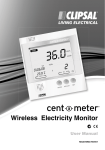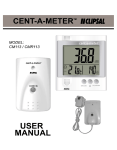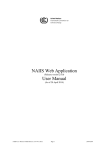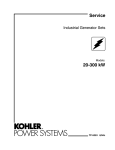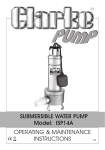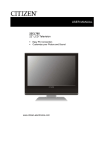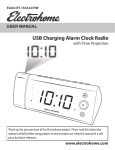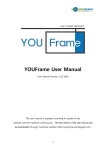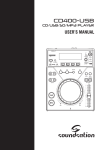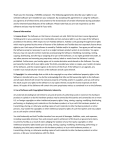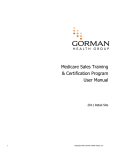Download USER MANUAL - Home Energy Metering.com
Transcript
USER MANUAL Model CM113A/CMR113A/CMS116 ® User Manual Version 12/18/2006 ® (MODEL CM113A / CMR113A / CMS116) TABLE OF CONTENTS Table of Contents .......................................................................................................................................................................1 Introduction.................................................................................................................................................................................3 Key features ................................................................................................................................................................................3 Main unit (Receiver) – Model CM113A .............................................................................................................................. Remote Transmitter – Model CMR113A ............................................................................................................................ Current Sensor – Model CMS116 ...................................................................................................................................... LCD display symbols .......................................................................................................................................................... Safety and Care Instructions ...................................................................................................................................................6 Warnings............................................................................................................................................................................. Safety precautions .............................................................................................................................................................. Caring for your product....................................................................................................................................................... Quick Install Guide ....................................................................................................................................................................7 How the product works .......................................................................................................................................................8 Overview ............................................................................................................................................................................. Voltage and current ............................................................................................................................................................ Watts and Kilowatts ............................................................................................................................................................ Household power cables and ‘phase’ ................................................................................................................................ Greenhouse gas ................................................................................................................................................................. ® Getting started ............................................................................................................................................................................9 You will need ...................................................................................................................................................................... Unpacking the product........................................................................................................................................................ Batteries ............................................................................................................................................................................ Loading the batteries.......................................................................................................................................................... AC adapter ......................................................................................................................................................................... Mounting the Centameter ................................................................................................................................................. Attaching the current sensors............................................................................................................................................. Plugging the current sensors into the remote transmitter .................................................................................................. Customizing settings ...............................................................................................................................................................11 Setting the voltage .............................................................................................................................................................. Setting the electricity voltage.............................................................................................................................................. Setting the cost-per-hour currency unit.............................................................................................................................. Setting the cost-per-hour value.......................................................................................................................................... Setting the greenhouse gas emissions per kW rate .......................................................................................................... Setting the power save mode ............................................................................................................................................. Main unit information ...............................................................................................................................................................13 To display power consumption in amps ............................................................................................................................. Setting the alarm ......................................................................................................................................................................13 Setting the alarm limit ......................................................................................................................................................... Activating the alarm ............................................................................................................................................................ Using the search and check function ....................................................................................................................................14 Using the search function ................................................................................................................................................... Resetting the main unit receiver and remote transmitter ................................................................................................... Temperature and humidity ......................................................................................................................................................15 Troubleshooting guide ............................................................................................................................................................16 1 Specifications ........................................................................................................................................................................... 16 Declaration of Conformity .......................................................................................................................................................17 Default Values...........................................................................................................................................................................18 Warranty ....................................................................................................................................................................................18 Proof of Purchase ....................................................................................................................................................................19 Centameter is a product of WIRELESS MONITORS AUSTRALIA PTY LTD - ACN 098 657 231 ® Manufactured under license in China 2 INTRODUCTION Thank you for selecting the Centameter household electricity monitor. This product was developed to educate people about the need to use energy in a sustainable manner and to not waste our scarce resources. By providing you with instant feedback about the cost of electricity consumption, university research and field trails have shown that it is possible to reduce your electricity cost by up to 20% by careful selection and operation of energy efficient appliances. ® It is designed to give many years of reliable service if used correctly, and performs the following functions: • • • • • • Monitors and displays electricity cost-per-hour in dollars, pounds or euros Monitors and displays total household electricity consumption Calculates greenhouse gas emissions per hour Alerts user to peak load electricity limits via alarm function Displays temperature and humidity inside the home Performs a home safety function, checking operating appliances NOTE To check if you have left any appliances operating that should have been turned off when you go to bed or leave the home unattended, simply check the receiver display. If it is higher that usual, investigate the cause and turn off any unnecessary appliances. In this way you may avoid an electrical house fire. This manual contains important safety and care information, and provides step-by-step instructions for using this product. Read the manual thoroughly, and keep it in a safe place in case you need to refer to it later. KEY FEATURES Main Unit - Receiver Front view A. Main LCD Screen B. Mode Button a) Toggle between different display screens b) Enable adjustment of settings C. Adjust Button Used to adjust values D. Alarm Button Enable/Adjust alarm settings Back view E. Wall-Mount Recess Hole For mounting the unit to a wall F. Search Button To search for and calibrate with Remote Transmitter G. On/Off Alarm Button Turn Alarm on or off H. Reset Hole Returns all settings to default values. I. Table Stand Can be pulled out and used to stand the unit on a flat surface J. Battery Compartment K. Plug pack power socket (optional) 3 Remote Transmitter Front Back A. Transmit Signal Light D. Reset Hole B. Check Button E. Battery Compartment (weather proof) Used to check reception with main unit Requires screwdriver to open C. Phase Connector Cable Outlets Current Sensors (2) A. B. C. D. E. F. G. Hinge Clip Sensor top part Hole for electricity phase wire Sensor body Sensor cable Plug 4 LCD Display Symbols SYMBOL MEANING DESCRIPTION Maximum receiving speed Information is received from the Transmitter every 6 seconds instead of every 1-minute. (Use with MAX set off to save battery life). Alarm limit activated The electricity cost-per-hour peak load limit is activated. The alarm will sound if it is exceeded. Cost per hour The instantaneous real-time cost per hour of electricity being used in your household in dollars, pounds or euros. Cents per kWh The amount (tariff) that your local electricity retailer charges for electricity per kWh (Kilowatt-hours). Kilowatts The total amount of energy being used in kilowatts Greenhouse gas display You are displaying greenhouse gas emissions information. Amperes The amount of current passing into your home Voltage The voltage setting for your household power line. Kilograms per hour The amount of greenhouse gas emissions per hour in kilograms, emitted by the power station. Tonnes per year The amount of greenhouse gas emissions per year in tonnes, emitted by the power station. Relative Humidity The current humidity level in your household. Temperature (Fahrenheit) The present temperature in your household. Humidity & Temperature condition Shows if the environment is comfortable. Humidity & Temperature condition Shows if the environment is dry. Humidity & Temperature condition Shows if the environment is wet. Alarm disabled/ Transmission broken The alarm is disabled, or the wireless signal from the Transmitter has been broken Low battery The batteries for either the 'main' receiver or 'remote' transmitter are low on power and should be replaced with new AA alkaline batteries. CENTS HOUR CENTS /kWh 5 SAFETY AND CARE INSTRUCTIONS WARNING To ensure you use your product correctly and safely, read these warnings and the User Manual before using the product. These warnings provide important safety information and should be observed at all times WARNINGS Attention cent-a-meter owner: ® Your safety is very important to us. We would like your attention regarding the installation of your Centameter. Sensors are to be located in the electrical panel which contains live electrical wires and components, and should therefore be installed by an electrician. ® • Take precautions when handling all battery types. They can cause injuries, burns, or property damage as a result of contact with conducting materials, heat, corrosive materials or explosives. Remove the batteries before storing the product for long periods of time. • Do not immerse the device in water. • Do not, under any circumstances, touch the exposed electronic circuitry of the device, as there is a danger of electric shock should it become exposed. • Take special care when handling a damaged LCD display, as the liquid crystals can be harmful to your health. • Do not use or store the device, including the remote sensor, in locations that may adversely affect the product such as rain, snow, desert, and magnetic fields. • Do not use this device in aircrafts or hospitals. The use of radio frequency products can cause malfunctions in the control devices of other equipment. • Do not subject the product to impact or shock. • When disposing of this product, do so in accordance with your local waste disposal regulations Safety precautions Please observe the following safety precautions when setting up and using this product. • LCD panel – The LCD panel is made of glass, and may break if the unit is dropped or impacted. • Heat sources – Keep the product away from heat sources such as radiators, stoves, heaters, and other heatgenerating products. • Water and moisture – Do not use the product in or near water or in high moisture areas such as a bathroom. • Power source – The product may be susceptible to power surges, and the Current Sensor cable should be disconnected from the Transmitter during severe storms. Caring for your product To ensure you receive the maximum benefit from using this product, please observe the following guidelines. • Cleaning – Disconnect the Current Sensor and remove the batteries from the Remote Transmitter and the Main Unit Receiver before cleaning. Use a damp cloth. Do not use liquid cleaning agents, benzene, thinner, or aerosols. • Air circulation - the vents and other openings allow air circulation for measurement of temperature and humidity and should not be blocked or covered. • Repair – Do not attempt to repair the product or modify the circuitry by yourself. Contact the retailer or a qualified repairman if the product requires servicing. Only use replacement parts that are recommended by the manufacturer. • Do not scratch hard objects against the LCD display as this may cause damage. 6 CENTAMETER QUICK START GUIDE ® Section I Installation in 200A Service Fuse Panel Main Unit Receiver Remote Transmitter (With Wall Bracket) Current Sensors Batteries x 6 AA Alkaline User manual & Quick Install Guide ATTENTION CENTAMETER OWNER: Your safety is very important to us. We would like your attention regarding the installation of your Centameter. Sensors are to be located in the electrical panel which contains live electrical wires and components, and should therefore be installed by an electrician. Step 1: Install clip-on sensors on the two incoming lines in the electrical panel service entrance, ensuring the sensors do not interfere with the re-installation of the panel cover. Feed the sensors cables through a “knock-out” hole in the side of the panel in the direction of the transmitter. Step 2: Find a location to mount the transmitter bracket on the wall close to fuse panel (screws not included). Check distance using sensor cables to ensure that they will comfortably reach the transmitter without stretching. Step 3: Unscrew battery cover (4 small Phillips head x-head) on back of transmitter, install batteries and replace cover. Step 4: Insert sensor cables into any two plugs at bottom front of the remote transmitter. Step 5: Now remove battery cover on wireless display and install 3 remaining batteries. (NOTE: receiver may not “find” transmitter if batteries are not installed into transmitter before receiver) Step 6: Push “Check” button on Transmitter (red LED flashes) and then push “Reset” on receiver. Step 7: Push “Search” on receiver and now receiver and transmitter should be communicating and displaying consumption information on the wireless display. Step 8: For trouble shooting Guide refer to page 16 Step 1: Voltage – For North America, leave at default setting of 120V. An alternate voltage can be set as follows: Press Mode and Alarm simultaneously. The voltage setting will be displayed. Press the Mode again. The display will blink. Press the Arrow key and repeat to scroll to 110V. Press Mode to confirm. Step 2: Price – Input total price ($/kWh) on your utility bill (include all charges except for the customer charge, + taxes). Press and hold Mode for 2 seconds. The digits will flash. Use the Arrow key to adjust each value (0-9). Press Mode to confirm. Repeat for remaining digits. Press Mode to confirm. Step 3: Greenhouse Gas (GHG in kg/hour per kWh): Press Mode until the Greenhouse Gas value is displayed. Press and hold Mode for 2 seconds. The unit blinks. Press the Arrow key to select kg/hour. Press Mode to confirm. The Greenhouse Gas emission value blinks. Use the Arrow keys to change the rate to 1.0 kg/hour (contact your Utility to confirm). Press Mode to confirm. Section II Customizing Your Settings Your Centameter is now properly configured for use - Enjoy! 7 HOW THE PRODUCT WORKS ® Overview This product uses ‘phase’ current transformer sensing technology to detect and monitor a magnetic field around your household electricity power cable. It measures the amps being used and, by reference to the system voltage, calculates the amount of power being used, the cost, and the amount of greenhouse gas emissions. It then transmits this information from the Transmitter to a cordless Main Unit Receiver on a frequency of 433MHz, from up to 30 metres away (unbroken transmission). The product is primarily intended as an educational device to aid understanding of the cost of operating electrical appliances in the home. As such, it is not intended to replace your accurate electricity revenue meter, so it cannot be used to check your electricity account. What is voltage and current? Voltage (volt) is the measure of electrical potential. Current signifies the amount of electricity flowing through a conductive material, such as a wire. Electrical current is measured in amperes or “amps” for short. Both Amps and Volts are necessary to provide electricity for your household appliances. Power is measured in Watts, and is the product of Volts times Amps. For a particular location, the voltage is usually constant – so the amount of power used is directly proportional to the current used. Watts and Kilowatts Watt Kilowatt (kW) Kilowatt-hours (kWh) A Watt is the standard unit of measurement for the amount of energy (electric or otherwise) being transferred to or from somewhere each second. A Kilowatt (kW) is simply a larger unit of measurement (1000 watts = one kilowatt). Kilowatt-hours (kWh) represents the use of 1000 watts of electricity for one whole hour. Refer to the following table: 1 kWh is the equivalent of ten 100-watt bulbs burning at the same time for one hour. Household ‘power’ cable and ‘phase’ Most household electricity supplies use single ‘phase’ current, where the current flows to and from your household appliances using a ‘neutral’ and two ‘power’ lines. The neutral line has a voltage close to 0 while the ‘power’ lines carry a fluctuating voltage or ‘phase’. The difference between these two lines makes the current flow through your appliances. The Current Sensors should be connected to each power line before using the Centameter. ® Caution: the sensors should be installed by an electrician. Greenhouse gas Fossil fuel power stations emit gases such as carbon dioxide when producing electricity. This causes an atmospheric imbalance, which in turn has been linked to global warming (global temperature rise). Every power station has a slightly different ratio of emissions to electricity production, depending on their methods. The default greenhouse emission rate on the Main Receiver is set to1 kilogram of greenhouse gas for every 1KW of electricity produced (1:00). This can be changed depending upon the fuel or energy source used by your power generating authority (see customized settings). 8 GETTING STARTED You will need As you unpack and begin to set up your new Centameter you will need the following equipment: ®® • User manual – for instructions on how to set up and use the product. • A hammer and 2x 2mm head nails – to fix the mounting bracket/unit to the wall. Alternatively you may screw the bracket to the wall or simply place the transmitter carefully inside the meterbox. • A small Philip’s-head screw driver - to open the battery compartment of the Transmitter. Unpacking the product When you unpack your Centameter, make sure to keep all the packing materials in a safe place, in case you need to later transport or return it for servicing. ® In the box, you will find: Main Unit Receiver Remote Transmitter (with wall Bracket) Current Sensors Batteries x 6 AA alkaline User Manual & Quick Install Guide Batteries The Portable Main Unit Receiver and the Remote Transmitter both use 3 x UM-3/AA 1.5V alkaline batteries. No other power source is necessary to run the units. When replacing the batteries, alkaline cells are strongly recommended. Loading the batteries: Main unit – Receiver Diagram Instructions Diagram Install the batteries by matching the correct polarity. Always use the correct battery type (3 x UM-3/AA 1.5V alkaline batteries). Instructions Remove the cover with a screwdriver. Then follow the same instructions as the main unit. Once done, replace the cover and screw back the cover onto the unit. Warning: Reversing the polarity may damage the product. NOTE Replace the batteries whenever the weak battery mark ‘main’ or ‘remote’ () shows, the display is dim, or the display does not illuminate when the power is on. Replace all the batteries at the same time – it is unwise to mix old and new batteries. Alkaline cells are strongly recommended. Contact your local waste disposal authority for instructions on how to dispose of used batteries. Used batteries can be harmful to the environment, and should not be thrown out with household garbage. AC Adapter The main unit receiver can operate with a 6.0V AC/DC adapter, which can be purchased separately. 9 Mounting the Centameter electrisave™ The Main Unit Receiver can either be placed on a flat surface with the back stand pulled out or mounted as shown below: Diagram Instructions 1. Mount by using nails or screws. 2. Hammer in nail or screw halfway. 3. Attach main unit The Remote Transmitter should be placed on a flat surface or mounted on a wall using the wall bracket provided within 30 metres of the Main Unit Receiver. It should be mounted outside of the electrical meter or fuse box, if these are made of metal. WARNING: If installed inside a metal meter box, the signal transmission distance between the remote transmitter and the main receiver will be reduced. To fix the wall bracket follow the instructions below: Diagram Instructions 1. Position the wall bracket. 2. Insert nail or screw through the mounting hole. 3. Hammer in nail or fix the screw halfway. 4. Attach wall bracket. 5. Slide Remote Transmitter into place. Attaching the Current Sensor Caution: the sensors should be installed by an electrician. To attach the Current Sensors to the household power lines (see HOW THE PRODUCT WORKS) follow the steps below: ® 1. Open the clip. 2. Lift the top of the Sensor away. 3. Place the main household active or phase cable into the Sensor cable hole. 4. Close the top of the Sensor. 5. Close the clip. 6. Plug the Sensor Transmitter cable into any one of the Transmitter jacks. 10 Plugging the Current Sensors into the Remote Transmitter Once the Current Sensors are attached to the household power lines you may plug them into any two of the three outlets in the Remote Electricity Monitor by following the steps below: Diagram Instructions 1. Choose one of the three outlets. 2. Plug in. WARNING: The signal wiring (approx 1volt, 1 milliamp) on the current sensors are double insulated suitable for installation in a 240 volt domestic power supply meter box. When passing through an enclosure opening the wiring should be protected from sharp edges by fixed bushes. WARNING: Do not allow the monitor to be used if it is damaged, or its safety is impaired It is possible to purchase an additional Current Sensor to handle a 3-phase service. This may be useful in buildings with high rates of power consumption such as factories or offices. If more than one Current Sensor is in use the total power consumption rate displayed will be a combined reading. CUSTOMIZING SETTINGS When the Remote Transmitter and Current Sensors have been connected, the Centameter Main Unit Receiver immediately starts receiving information. The LCD screen displays electricity consumption and greenhouse gas readings based on default factory settings (see SPECIFICATIONS). In order to obtain a more accurate reading, it is advisable to make more customized settings. Setting the Voltage NOTE As the default value is 120V, a voltage setting is not required for a product used in North America. The ‘voltage’ of the power line you are monitoring (see Voltage and current) can be set by following the instructions below Setting the electricity voltage (default is 120V; to reset to 120V remove and re-install batteries). Diagram Instructions 1. Press mode and alarm simultaneously. The current voltage setting is displayed. 2. Press mode again. The voltage value blinks. 3. Use the arrow key to change the value. (110-250) Press mode when finished. The Centameter initially displays the electricity cost-per-hour as a default or factory setting of 12 cents per kWh (see Watts and Kilowatts). To find the local electricity charge per kWh, refer to your last electricity bill and then change the currency unit and value by following the instructions below: 11 Setting the cost-per-hour currency unit Diagram Instructions 1. Press mode and alarm simultaneously. 2. The currency value blinks. Use the arrow key to change the flashing value (in $, £, or €) 3. Press mode to set value. 4. Press mode when finished. Setting the cost-per-hour value Diagram Instructions 1. Press and hold mode for 2 seconds. The first digit of the electricity cost-per-hour flashes. 2. Use the arrow key to change the flashing value (0-9). Press mode to set value. Repeat for all digits. 3. Press mode when finished. Setting the greenhouse gas emission per kW rate (see Greenhouse Gas) To set the unit and rate of greenhouse gas emissions per electric current production (see Greenhouse gas) follow the instructions below: Diagram Instructions 1. Press mode to change to the Greenhouse Gas display. 2. Press and hold mode for 2 seconds. 3. The Greenhouse Gas emission unit blinks. Use the arrow key to toggle between units (Kg/Hour or Ton/Year). Press mode to confirm. 4. The Greenhouse Gas value blinks. Use the arrow key to change the value. 5. Press mode again to return to the Greenhouse gas display. NOTE It may be necessary to change this setting depending on where you live. If a precise rate is required or if you have purchased a “Green Energy” product, contact your local electricity retailer. Setting the Battery power save mode You can save battery power by changing the receiving speed of the Main Unit Receiver from every 6 seconds (MAX) to every minute. To change the setting, follow the instructions below: 12 Diagram Instructions 1. When ‘MAX’ icon is displayed, press and hold the arrow key for 2 seconds. 2. The ‘MAX’ icon disappears. Repeat these steps to re-enable “MAX’ receiving speed. NOTE Use the standard real-time update cycle until you have become familiar with the cost of operating electrical appliances around your home. Afterwards change the receiver to cycle every 1 minute to greatly increase the lifetime of the receiver batteries from about 4 months to over 12 months. MAIN UNIT INFORMATION After customizing your Centameter three types of information can be displayed on the main unit: ® • cost of household power consumption in dollars/pounds/euros per hour • amount of greenhouse gas emissions produced in kilograms per hour or tons per year • current household power consumption in kilowatts or amps (see Voltage and Current, Watts and Kilowatts) To display the information, simply use the mode key to switch between screens. To display power consumption in amps Household power consumption can be displayed in terms of amps instead of kilowatts (see HOW THE PRODUCT WORKS). To display the amount of electrical current passing into your home (amps), instead of the power (kW) follow the instructions below: ® Diagram Instructions 1. After having selected the power display in kW by pushing mode repeatedly, press and hold mode for 2 seconds. The AMP display is shown. 2. Press mode again to return to kW display. SETTING THE ALARM The Centameter comes equipped with an alarm that alerts users when the electricity cost-per-hour exceeds a pre-set limit. ® This helps control energy consumption and may reduce bills and the possibility of blackouts during peak load periods. To set the alarm limit To set the alarm limit follow the instructions below: 13 Diagram Instructions 1. Press alarm key once while in the "cost mode". 2. Use the arrow key to change a value. 3. Press alarm again and continue until all values are set. Activating the alarm To activate the alarm follow the instructions below: Diagram Instructions 1. On the back of the unit locate the grey alarm on/off button (furthest to the right). 2. Press the alarm on/off button once to activate or deactivate the alarm. 3. The Hi icon will appear when the alarm is activated and disappear when it is deactivated. NOTE The alarm will sound and the display will flash when the alarm limit is exceeded. It will cease if the cost-per-hour falls below the limit, or you can press any button to stop the alarm. A “——“ message means the alarm is disabled. USING THE SEARCH AND CHECK FUNCTIONS The Centameter Main Unit Receiver and Remote Transmitter include search and check functions to quickly re-establish a connection should the transmission be broken (i.e. if the units are too far apart, or experience interference from other devises such as a radio or television). ® Using the search function To activate the search and check function, follow the instructions below: Diagram Instructions Locate the search button on the back of the main unit receiver (left hand grey button). Press once and hold for 2 seconds (unit will beep twice). Connection with the Remote Electricity Monitor will be re-established. If no connection can be made, locate the check button on the remote transmitter. Press once. Press the search button on the back of the main unit receiver again as in step 1. NOTE Make sure you press the search button within 30 seconds of activating the check function. If a connection is not made try resetting both the Main Unit Receiver and the Remote Transmitter. If you are resetting to re-establish a connection between the units, the main receiver unit must be reset first 14 Resetting the Main Unit Receiver and the Remote Transmitter To reset both units to default factory settings follow the instructions below: Diagram Instructions 1. Locate the reset point on the back of the Portable Main Unit. 2. Push a blunt stylus (pen) gently into the reset point. 3. Follow the same steps for the Transmitter. NOTE If you are resetting to re-establish a connection between the Remote Transmitter and the Main Unit Receiver, then the Main Unit Receiver must be reset first. TEMPERATURE AND HUMIDITY An added feature of the electrisave™ is a temperature and humidity display function. Both temperature and humidity are alternately displayed in the bottom left hand corner of the Portable Main Unit for three seconds. Humidity is shown as a %, and temperature in degrees Fahrenheit oF . ® An additional feature of the humidity display is a series of icons to indicate if the environment is comfortable, dry or wet: Zone Temperature Relative Humidity 20 – 25 °C 68 - 77 °F 40 – 70% Any <40% Any <70% <20°C or > 25°C 40 – 70% NOTE The readings given are for the surrounding environment and may a change according to the position of the unit. HHH or LLL will be shown if the temperature is over or under range (+50 to –5c). 15 TROUBLESHOOTING GUIDE This section includes a list of frequently asked questions for problems you may encounter with your Centameter. If your Centameter is not operating as you think it should, check here before arranging for servicing. ® Problem No power or no reading “----“ reading “0.00“ reading Symptom Check this Remedy Batteries are exhausted Replace with new alkaline batteries Batteries are inserted incorrectly Insert the batteries correctly ( Batteries) “----“ display readings on LCD screen Remote and Main Unit are out of synchronisation or transmission has been broken Reset both units Current not detected No power being used or sensor Check sensor installation incorrectly installed. Power will not turn on or no display reading on LCD screen Alarm “----“ reading in Alarm mode Alarm disabled Activate alarm “----” flashing Automatic search underway - Allow search to run to completion Main unit receiver receives data from another remote transmitter Display does not respond as expected Incorrect transmitter detected during installation or following battery replacement or “reset” Refer to installation instructions NOTE After resetting the main unit receiver it may take up to 2 minutes to re-establish the communications link. This can be expedited by pressing the “CHECK” button on the remote transmitter for 2 seconds (beep) to force transmissions every 2 secs SPECIFICATIONS Dimensions Main Unit- Receiver Width x Height x Depth Weight 107 W x 117 H x 30 D mm 160 g Remote Transmitter Width x Height x Depth Weight 78 W x 113 H x 40 D mm 110 g Power On Factory Default Settings: AC voltage 1kg CO2 GHG unit (greenhouse gas) Kg/Hour GHG conversion Tariff charge (cost-per-hour) Temperature unit Currency Hi alarm Receiving cycle Display Mode 120 V 1 kW/hr 1 kg CO2 = 1 kW/hr 12.0 cents per kWh °F $ and cent $2.00/hour, on MAX 6 second Cost rate display 16 Current (RMS) Accuracy: Less than 1A 1A to <3A 3A to 71A Maximum Operating Current 71AMPS Selectable AC Voltage Setting Radio frequency: System Range Power: Power supply Operating environment: Operation temperature Storage temperature Tolerance Not Specified <10 % <5 % 110,220,230,240,250 Volt 433 MHz radio frequency 30 metres in open areas (partitions, walls, and electrical appliances may affect reception range) Main receiver – 3 x AA / 1.5v alkaline batteries (or 6.0V AC/DC adapter) Remote transmitter – 3 x AA / 1.5v alkaline batteries 5° C … 45° C (41° F…113° F) at 85% relative humidity -5° C ….60° C (23° F … 140° F) at 85% relative humidity Compliance: Manufactured to ISO9000 Quality Assurance Standards and tested for compliance with European CE Certification. RTTE/CE approved (Europe), FCC, UL (USA), IC, CSA (Canada) and applicable Australian and New Zealand Communications and Electricity Authorities Regulations. N12357 We DECLARATION OF CONFORMITY Name: Wireless Monitors Australia Pty Ltd Declare that the product Product No: Product Name: Manufacturer: Address: CM113A Centameter IDT Technology Limited Block C. 9/F Kaiser Estate, Phase1, 41 Man Yue St, Hung Hom, Kowloon, Hong Kong Is in conformity with IC / FCC and UL rules as tested to cETLus standards. This device is intended for use in North America. This equipment complies with the essential requirements for the Radio Equipment and Telecommunications Terminal Equipment Directive 1999/EC WARNING: Changes or modifications to this unit not expressly approved by the party responsible for compliance could void the users authority to operate the equipment. 17 DEFAULT VALUES FUNCTION DEFAULT VALUES A C Voltage 120 volt Greenhouse gas emission rate kW 1.0 Greenhouse gas unit kg/hour Tariff charge (cost per kWh) 12 cents per kWh Currency $ and cents Hi alarm $2.00 / hour, HI on Battery save (receiver) MAX off (battery save off) CUSTOMISED SETTINGS WARRANTY LIMITED ONE YEAR WARRANTY This Centameter is provided with the following warranty, subject to the following conditions: ® Wireless Monitors Australia Pty Ltd warrant this product for a period of 1 year from date of purchase for all defects in workmanship or materials. All defective parts will be replaced or repaired free of charge. The following exclusions do not exclude the purchaser from those statutory rights consumers have under consumer laws that exist in North America. Warranty Conditions 1. The product should be installed in strict accordance with instructions. Wireless Monitors Australia Pty Ltd will not accept liability for any damage or injury caused by mis-use or Non-compliance with the instructions 2. Warranty will only be given where proof of purchase date is provided. Eg. original invoice or copy. 3. This instrument must not be modified in any way. 4. Batteries are specifically excluded from this warranty. 5. Wireless Monitors Australia Pty Ltd will not be liable for indirect, consequential or incidental damages. 6. Wireless Monitors Australia Pty Ltd reserves the right to change specifications or designs described in this manual without notice or obligation. This product is distributed under license from Wireless Monitors Australia Pty Ltd by Eco-Response Technologies Inc. Internet: http://www.eco-response.ca Email: [email protected] Phone: 416-591-0101 18 Return Policy 1. Your Centameter is guaranteed for a period of 12 months from the date of purchase, subject to the conditions listed above. All defective units should be sent to the address shown below using a registered form of post. 2. Repaired and or replacement units will be supplied with 30 days of receipt of the unit(s) from the customer, with the customers being advised of any delay beyond this timeframe 3. To ensure returns for defective unit(s) are processed quickly, customers are required to send with returned unit(s) proof of purchase details as shown on the following page ® WARRANTY PROOF OF PURCHASE WARRANTY PROOF OF PURCHASE If you need any service or warranty support, please contact the Supplier giving the following details: Product Name: Centameter - Model CM113A, CMR113A, CMS116 Purchaser Name and Address: .............................................................................. .............................................................................. Supplier Name and Address: .............................................................................. .............................................................................. Date of Purchase: .............................................................................. Receipt or Invoice Number .............................................................................. NB Send a copy of this page and a copy of purchase receipt or invoice with the unit(s) you are returning 19





















